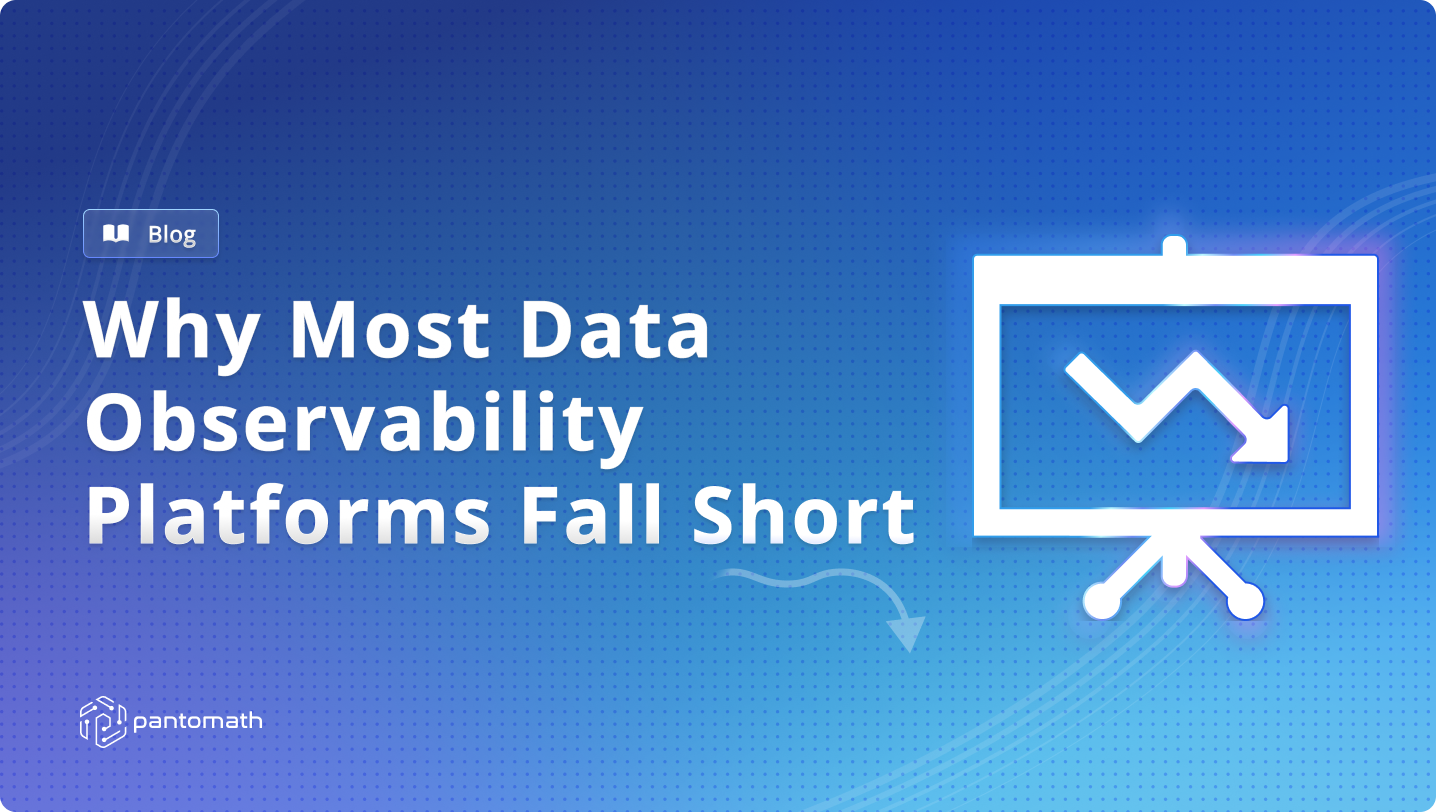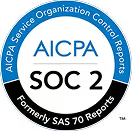
In boardrooms across the globe, executives are grappling with a painful truth: the data tools they've invested in aren't delivering on their promises. Learn why in this blog.
Why Most Data Observability Platforms Fall Short
In boardrooms across the globe, executives are grappling with a painful truth: the data tools they've invested in aren't delivering on their promises. Despite the hype and hefty price tags, these solutions often fall short of solving the complex data challenges facing modern enterprises. But why?
In short, there's a gap between the capabilities of these tools and the real-world needs of businesses. Many data solutions are designed with ideal scenarios in mind, assuming clean, well-structured data and straightforward use cases. However, the reality in most organizations is far messier.
Take Pantomath’s bread and butter – data observability. Data observability platforms promise a utopian vision: complete visibility into your data ecosystem, automated anomaly detection, clear observability metrics and analysis, seamless data lineage tracking.
While it's a compelling pitch, it often crumbles under the weight of real-world complexity.
The data observability platform (over)promise
In the race to solve data management challenges, data solutions vendors often paint a picture that borders on fantasy or magic. These platforms promise to be the panacea for all your data woes - from quality issues to lineage tracking, from anomaly detection to impact analysis.
It's a seductive vision: a single tool that can monitor, manage, and maintain your entire data ecosystem with minimal effort. But as with many things in the complex world of enterprise data, the reality falls short of the glossy sales pitch. Let's peel back the layers of these promises.
Data lineage tracking
The promise: End-to-end visibility of data flow across your entire ecosystem, from source to consumption.
The reality: Most platforms provide only high-level lineage, showing data-at-rest lineage within a single system but failing to capture cross-platform or inter-system lineage and also miss critical data-in-motion components such as transformations within complex data pipelines and ETL processes. True pipeline traceability requires technical and granular, job-level tracking of data as it moves and transforms. Many platforms can't penetrate the "black box" of data processing steps, leaving crucial gaps in understanding how data changes over time.
Impact analysis
The promise: Instant insights into how changes in one part of your data ecosystem will affect downstream processes and analytics.
The reality: Impact analysis is often limited to simple, direct relationships between data assets. It frequently misses complex dependencies or indirect impacts. Fully accurate impact analysis requires a deep understanding of both technical dependencies and business processes. Most platforms lack that contextual awareness. Without true impact analysis driven by end-to-end pipeline traceability, it is also challenging to resolve data incidents since every individual job in the critical path of a data pipeline needs to be sequentially re-run to ensure the entire pipeline has refreshed and accurate data.
Data quality monitoring
The promise: Data observability platforms promise continuous monitoring of data quality across all data assets, with automatic alerts for any deviations from defined standards.
The reality: Most platforms rely on predefined rules and thresholds, which can miss nuanced or context-specific quality issues. They often struggle with unstructured data or complex data types, leaving significant blind spots in your data quality assessment. Real-world data quality issues are often subtle and context-dependent. A platform that doesn't understand your business logic can't truly assess data quality. Plus, as data volumes grow, these systems often become overwhelmed, leading to alert fatigue or missed issues.
Metadata management
The promise: A comprehensive catalog of all your data assets, providing clear definitions, ownership information, and usage metrics.
The reality: While platforms can collect basic metadata, they often struggle to keep this information up-to-date in dynamic environments. They may miss important contextual metadata or fail to capture the relationships between different data elements accurately. Effective metadata management requires ongoing human input and curation. Automated systems sometimes lack the nuanced understanding required to interpret and categorize metadata.
The missing pieces: Job-level pipeline traceability + data in motion monitoring
While traditional data observability platforms fall short in numerous ways, two critical capabilities are conspicuously absent from most offerings: job-level pipeline traceability and data in motion monitoring. These features represent the next evolution in data observability. Here’s how.
Job-level pipeline traceability
Job-level pipeline traceability is the ability to track data lineage at the most granular level, following data through every transformation, join, and aggregation within your data pipelines.
Why this is crucial:
- Root cause analysis: When data issues arise, job-level traceability doesn’t just point out that there is an issue, it points out where it stems from, down to the actual job that needs to be fixed (see how it works with Pantomath).
- Impact assessment: Understanding how data transforms at each step gives you the power to assess the impact of changes or issues on downstream processes and analytics and a path to resolve the issue across the entire pipeline.
- Compliance and auditing: Granular traceability provides the detailed audit trails necessary for regulatory compliance in many industries.
Data in motion monitoring
Data in motion monitoring involves observing and analyzing data as it flows through your systems in real-time, rather than just examining it at rest. With this type of operational observability, you can easily spot job failures, data latency, not started jobs and data movement.
Why this matters:
- Catch issues at their source: Data at rest issues are generally the symptom, not the root cause. For example, a table doesn’t lose rows by itself. It is generally an upstream data in motion component that causes this impact.
- Reduce alert-fatigue: Get consolidated alerts due to a unique understanding of the correlations across end-to-end data pipeline instead of getting over alerted.
- Immediate issue detection: Catch data quality problems, anomalies, or pipeline failures as they happen, not hours or days later.
- Performance optimization: Monitor the health and performance of your data pipelines in real-time, allowing for immediate interventions.
- SLA compliance: Ensure that data is moving through your systems within expected timeframes.
- Adaptive data quality: Implement dynamic data quality rules that evolve based on real-time data patterns.
Most data observability platforms focus on static analysis of data at rest or provide high-level overviews of data movement. In contrast, job-level pipeline traceability and data in motion monitoring offer the granularity teams actually need.
Instead of just showing that data moved from point A to point B, these features reveal every transformation and processing step in between. And, with real-time insights, rather than relying on scheduled scans or batch processes, these capabilities provide immediate visibility into your data ecosystem.
Granular traceability and real-time monitoring allows for predictive analytics and proactive issue resolution. In the long-term, this kind of strong observability foundation can handle the volume, velocity, and variety of data in your scaling ecosystem.
Real-world consequences of inadequate data observability
The case of Lendly, a rapidly growing online lender, starkly illustrates what happens when data tools fail to plug all of the requisite gaps.
Despite using popular tools like Fivetran, Snowflake, dbt, and Tableau, Lendly's data team was spending a staggering 30% of their time identifying and debugging data and pipeline issues. Business users often became the first line of detection for reliability issues, putting the data team on the back foot.
With data refreshes occurring as frequently as every 15 minutes, unresolved issues could quickly snowball, potentially impacting critical operations like loan approvals or customer service.
This situation not only hampered the data team's ability to focus on revenue-generating analytics but also risked eroding trust in data across the company. The potential for flawed business decisions based on unreliable data loomed large, threatening Lendly's core business of providing quick, reliable loans. Observability oversights like the one that occurred here can have far-reaching consequences, from financial losses to damaged customer relationships and regulatory non-compliance.
What to look for in a truly effective data observability solution
As we've seen, not all data observability platforms are created equal. To overcome the limitations of traditional solutions, look for more advanced capabilities. Here are the key features and capabilities that set truly effective data observability solutions apart:
1. End-to-end pipeline traceability – Look for a solution that offers granular visibility into your data pipelines. This means traceability that goes beyond high-level data flows to show you exactly how data is transformed at each step of the process.
Key capabilities:
- Visibility into individual jobs and transformations within pipelines
- Ability to track data lineage across complex, multi-step processes
- Real-time updates on pipeline status and performance
2. Data in motion monitoring – Effective data observability requires the ability to monitor data as it flows through your systems, not just when it's at rest.
Key capabilities:
- Real-time monitoring of data quality and pipeline health
- Ability to detect anomalies and issues as they occur, not after the fact
- Dynamic adjustment of monitoring rules based on changing data patterns
3. Extensive data catalog – A comprehensive data catalog is essential for understanding your data assets and their relationships.
Key capabilities:
- Automatic discovery and cataloging of data assets
- Rich metadata management, including business context and data lineage
- Search and exploration features to help users find and understand data
True data observability brings together these elements to provide a holistic view of your data ecosystem. Look for end-to-end visibility across your entire data stack. Ideally, a single platform should be able to integrate pipeline, quality, and catalog insights in practice, not just in theory.
Plus, alerts should be actionable, and bring with them recommendations for issue resolution. It’s not enough to say “Something bad happened.” You need: “Something bad happened, here’s how to fix it.”
Rethinking data observability
The hard truth is that no single platform can solve all your data problems. True data observability requires a multifaceted approach that goes beyond what traditional platforms offer. It demands a combination of advanced technology, tailored processes, and a data-aware culture.
At Pantomath, we've developed a solution that addresses these critical gaps in traditional data observability. We combine end-to-end pipeline traceability with advanced data in motion and data at rest observability. We believe that true data observability is not just about monitoring; it's about harnessing the full potential of your data with confidence.
Ready to move beyond the limitations of traditional data observability platforms? Demo Pantomath today and discover how we're redefining what's possible in data quality management.
Keep Reading
.png)
October 28, 2025
Pantomath Achieves ISO/IEC 27001:2022 CertificationPantomath announced today that it has achieved ISO/IEC 27001:2022 certification for its Information Security Management System (ISMS).
Read More.png)
October 27, 2025
Rethinking Incident Response: How Agentic AI Transforms L1 to L3 WorkflowsDiscover how Agentic AI transforms L1–L3 incident response, automating root cause analysis and streamlining data operations across the enterprise.
Read More
September 30, 2025
Why Data Teams Need Unified SchedulingData operations don’t fail because of tools, they fail because they’re fragmented. A unified scheduling view brings order, reliability, and confidence - see how.
Read More







